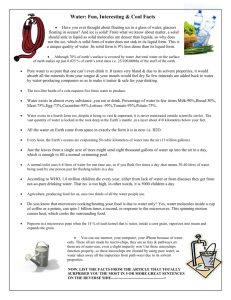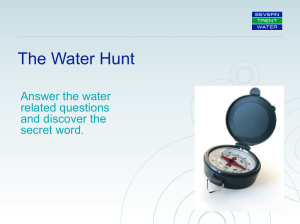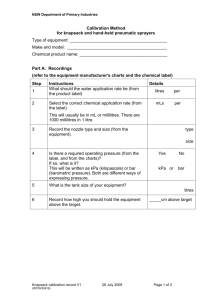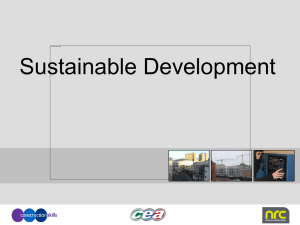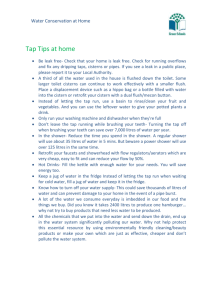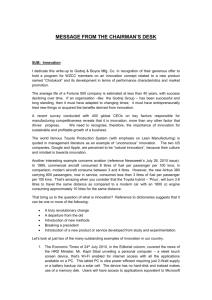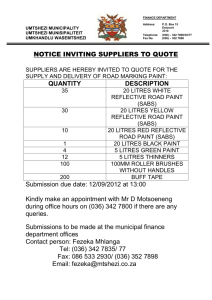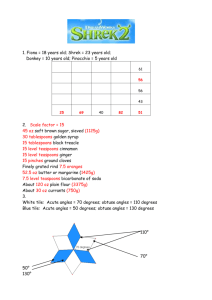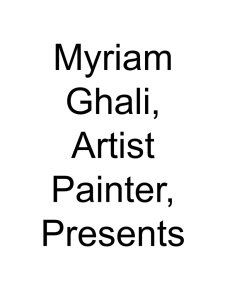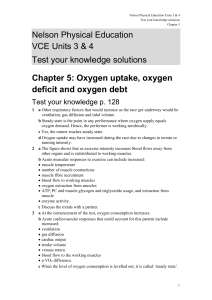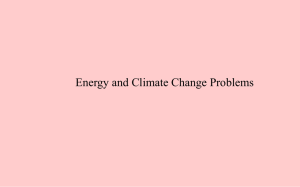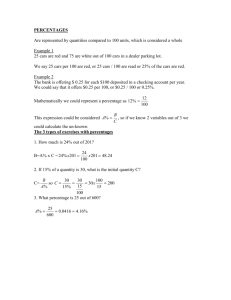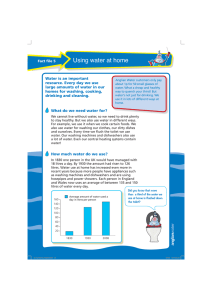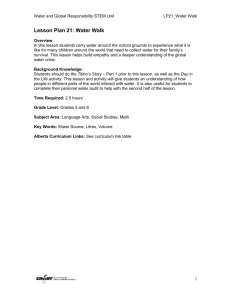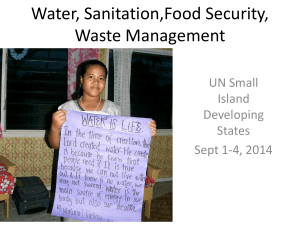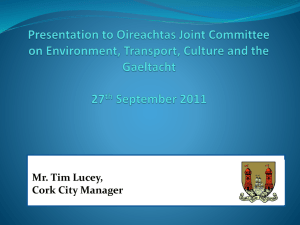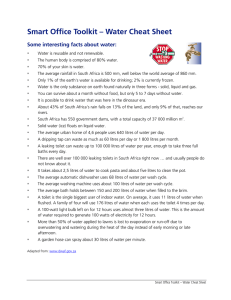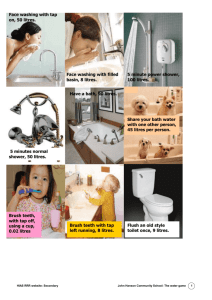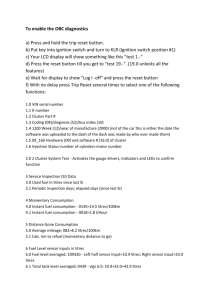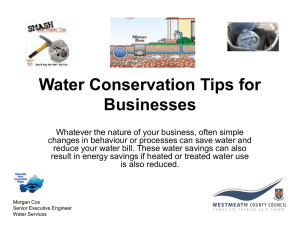Developing Countries presentation (PPT 8.1mb) - Publications
advertisement
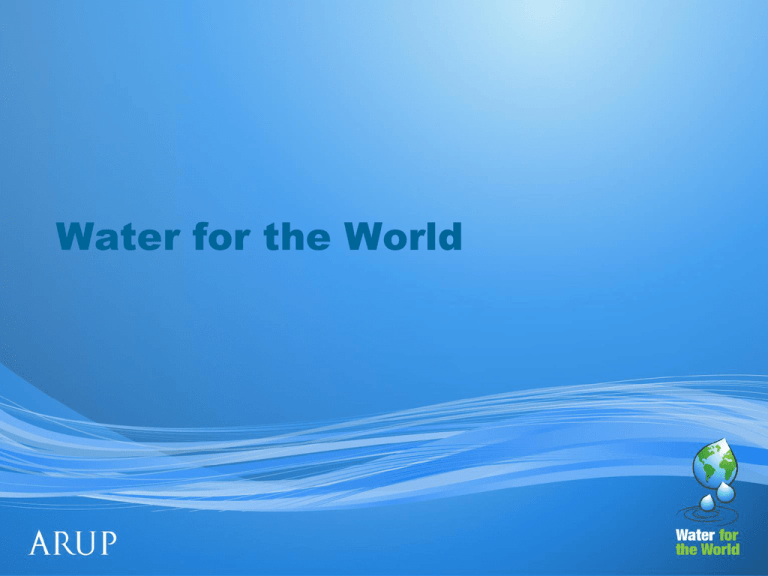
Water for the World Quick Quiz… What percentage of the world’s water can we drink? A. 0.8% B. 6% C. 19% D. 30% A. 0.8% 0.8 % fresh water 1.7 % ice, glaciers Ludovik Hirlimann www.forestwander.com 97.5 % sea water Andrew Hux How many people in the world are without access to drinking water? A. 1.1 million B. 6.7 billion C. 1.1 billion D. 2.6 billion C.1.1 billion (1 in 6 people) 6.7 7 6 5 4 People (billion) 2.6 3 1.1 2 1 or ld w pe op le in th e sa at er fo r w w ith o ut dr in ki ng w ni ta tio n at er 0 On average how many litres of water do people in the UK use a day? A. 50 B. 100 C. 150 D. 200 C. 150 litres = 10 litres UK Average 150 litres UK Average 150 litres Mozambique 8 litres America 350 litres How many litres are lost through leaks in this country per day? A. 2 million B. 50 million C. 500 million D. 900 million D. 900 million Canary Wharf Dwellings (55%) Non dwellings (25%) Lost in transmission (20%) What percentage of domestic water is used for flushing toilets in the UK? A. 10% B. 20% C. 25% D. 30% D. 30% Outdoor 7% Clothes washing 13% Other 5% Toilets 30% Cooking 4% Washing up 8% Shower & sinks 33% Personal Water Usage How long can we live without food? 4-8 weeks How long can we live without water? 3-5 days Really?! How much do we need per day? 30 – 50 L Okay… How much do we use? 140 – 160 L Where does it all go? Brushing teeth : 0.01 - 1 L Drinking: 1–2L Cooking: 1–5L Washing hands and face: 1–3L Flushing the toilet: 5 – 10 L Having a power shower/bath: 50 – 150 L Having a shower: 1 – 40 L Washing machine: 30 – 100 L Dish washer: 30 – 100 L Cleaning car: 5 – 200 L Watering Garden: 1 – 17 L/m2 Total on average person: 140 – 160 L Water Consumption Hoekstra, A.Y. and Chapagain, A.K. (2008) Globalization of water: Sharing the planet's freshwater resources, Blackwell Publishing, Oxford, UK Availability of Water World Resources Institute - PAGE, 2000 Water Scarcity International Water Management Institute From Plant to the You! How does water get to us? River “source” Add chemicals Stir Distributee Settle Filter Store Disinfect Water Treatment Plant Arup Alternative Water Sources Ground Well http://upload.wikimedia.org/wikipedia/commons/0/01/Faryab-_village_dug_well.JPG Alternative Water Sources Springs Alternative Water Sources Surface Water – Lakes and Rivers Courtesy of Indrajit Shah Alternative Water Sources Sea – Thermal Desalination or Reverse Osmosis Arup Alternative Water Sources Rainwater Harvesting What about Developing Countries? What is a Developing Country? What does “available water” mean to them? What are the constrains posed by water scarcity to people in those countries? What is a Developing Country? Low standards of democratic governments Weak economy Low standards of industry Low standards of social welfare and social programs Low standards human rights World Development Map Advanced economies Emerging economies Developing economies Source: IMF Water Infrastructure in Developing Countries No pipelines to rural areas Water Delivery by Water-tank Cars Anokhee Shah, Lack of Infrastructure in Developing Countries Groundwater - Well with Pump WaterAId Walking long distances People have to go to water sources Women and children collect the water In parts of Africa people walk up to 20 km per day to get clean water Contamination Water can be contaminated by: Micro organisms Bacteria: Salmonela (enterobacteria) causes diarrohea : Bacteria, Viruses, Protozoa, Metazoa Virus: Rotavirus is the leading single cause of severe diarrohea among infants and young children, and is one of several viruses that cause infections commonly known as stomach flu Source: http://en.wikipedia.org Protozoa: Causes severe diarrohea, epigastric pain, bloating, nausea, diminished interest in food, possible vomiting and weight loss Metazoa: Ascaris Ascariatis – Ingested eggs release larvae which matures to adult worms inside the human host. A female worm can produce up to 200.000 eggs/day. Contamination Water can be contaminated by: Dissolved chemicals : Dissolved chemicals can be toxic, carcinogenic, mutanogenic, corrosive, irritant and may cause irreparable damage to the environment. Raw sewage and industrial waste Source: http://en.wikipedia.org/wiki/File:Nrborderborderentrythreecolorsmay05-1-.JPG Contamination Particulates (small bits) : Sediment Pollution (Muddy River Effect) Source: http://en.wikipedia.org/wiki/File:Muddy_USGS.jpg Contamination Contamination brings diseases such as: Cholera Typhoid fever Salmonella These diseases are the biggest cause of mortality in developing countries. Treatment – Simple Technology Potters for Peace – Ceramic Water Filters Slow sand filtration – Biosand Filter Potters for Peace www.biosandfilter.org Water Filter Challenge! In groups, make a WORKABLE water filter Each group = A Country Follow the instruction sheet Buy supplies Demonstrate filter at end. Rules of the Challenge! Only 1 person per group buys at a time. You can ONLY buy in the first 20 minutes. You can talk and deal with other groups. No cheating! – Not that you would … How does this relate to the real wold? Activity Real World Money difference Based on actual country’s Gross Domestic Product (GDP) Illegible instructions Based on actual country’s illiteracy rate Lack of education and access to information Resourcefulness People in poorer countries have their own ways of coping Countries share Richer countries may offer “Official Development Assistance” (ODA) to poorer countries Countries form groups like the G8, OECD, or Group of 24 Respect Goes with power. Challenges It’s not just about giving money and technology… … it’s about using the best long-term solution for the problem! Ownership – Are they going to care if everything is done for them? Is it going to last long? Training – who will fix it? What Can you Do? Discussion and Questions

